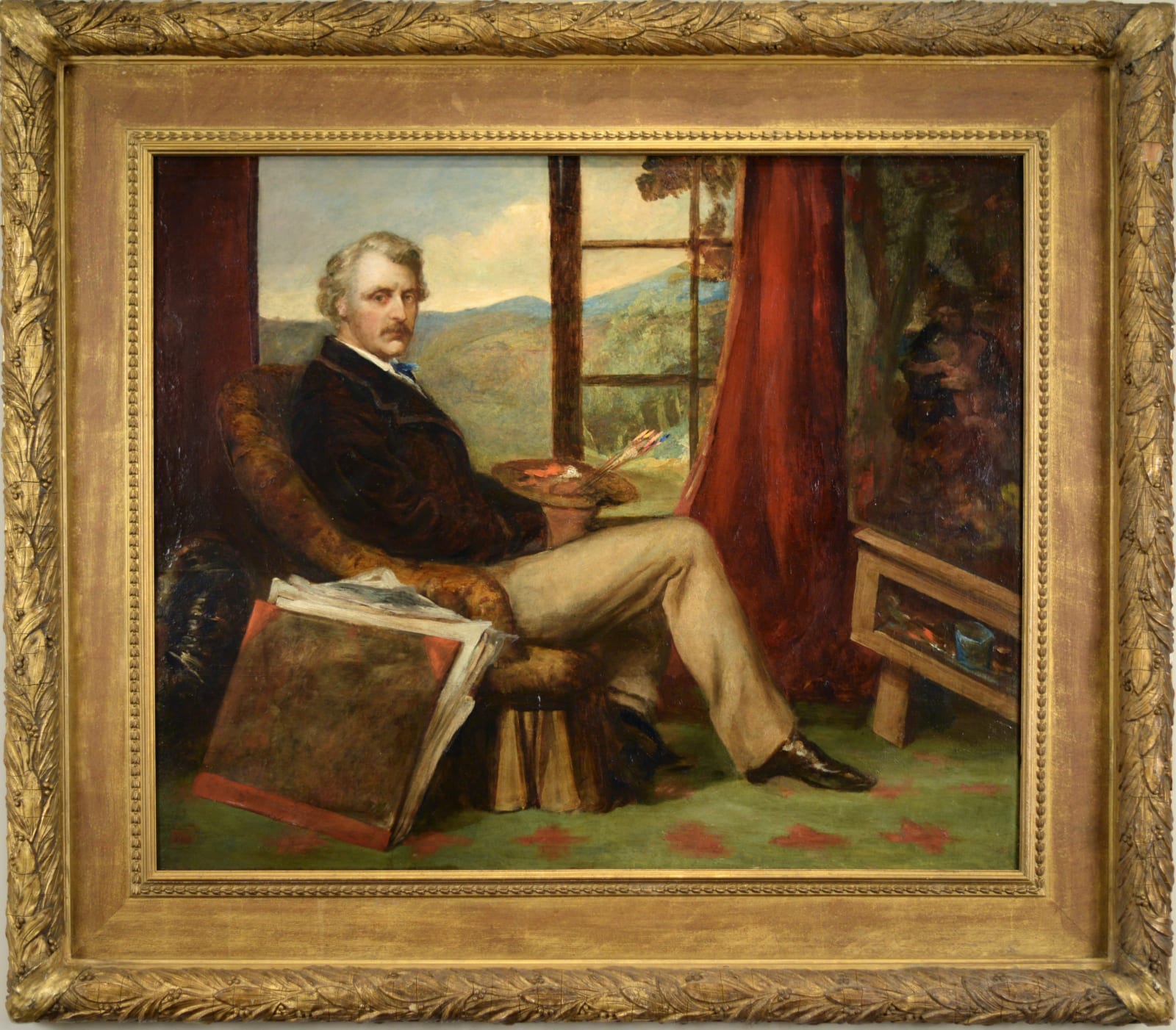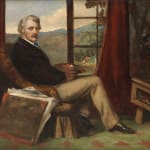Sir Coutts Lindsay (1824-1913)
Exhibitions
Yale Center for British Art, Denver Museum & Art Gallery, Laing Art Gallery, Newcastle on Tyne, The Grosvenor Gallery – A Palace of Art in Victorian England, 1996, no 32
Literature
Virginia Surtees, Coutts Lindsay, Michael Russell, Norwich, 1993
Susan P. Casteras and Colleen Denney, The Grosvenor Gallery, A Palace of Art in Victorian England, Yale University Press, 1996, p 195, cat no 32, ill pl 5
Lindsay, founder of the Grosvenor Gallery, showcase of the Aesthetic Movement, was one of the most influential and important men in the late Victorian art world. He probably painted this picture around 1864, the time of his marriage to Blanche Fitzroy (1844-1912), when Lindsay was 42, with greying hair. The view through the window behind him is probably of his estate at Balcarres, the Lindsay seat in Scotland, where Lindsay had a studio. He is wearing the same jacket that he wore posing with Blanche at Balcarres for a photograph by Thomas Buist. The picture on the easel is A Knight and His Daughter, a painting that he exhibited at the Grosvenor Gallery in 1879. There is a breast plate of armour (Lindsay had a large collection of armour) behind his chair and his portfolio. The ‘Venetian’ colour of the painting is in the manner of his friend Watts.
All his life, Lindsay was surrounded by art and artists. Both his parents sketched and painted in watercolour competently. In his youth Coutts had been close to his older second cousin Alexander, Lord Lindsay, who was a cultivated art historian who published his Sketches of The History of Christian Art (1847), dedicated to Coutts, which became a hugely influential book, awakening a strong interest in Italian art and leading to the founding of the Arundel Society. Lord Lindsay saw a great future for Coutts as a painter, as a 'second Benozzo Gozzoli', and taught him everything he could about art on repeated trips to Italy. In 1850, Coutts made the decision to devote his life to art and his love of Italy. He took lessons from William Mulready (1848), Ary Scheffer (Paris, 1850), Charles Sibley and William Leighton Leitch (1853). He frequented the Salon of Adelaide Sartoris in Rome in the early 1850’s, where he met many artists from different nations. He wrote plays and he also wrote about art, producing a discourse titled Painting in Oils, in 1871. His love of art extended beyond writing and painting however, and in 1877 he opened the Grosvenor Gallery with his partners Charles Edward Hallé and Joseph Comyns Carr. Lindsay alone decided who would exhibit at the new venue. The original guidelines barred Royal Academicians from exhibiting, but these were later revised. Each painting was displayed to its best advantage, evenly spaced, each artist to his own area, and nothing was 'skied.' The new gallery was an instant success, and Oscar Wilde described the opening exhibition thus:
'Taking a general view of the works exhibited here, we see that his dull land of England, with its short summer, its dreary rains and fogs, and factories, and vile deification of machinery, has yet produced very great masters of art, men with a subtle sense and love of what is beautiful, original, and noble in imagination.'
The Grosvenor Gallery came to be seen as the platform of the Aesthetic Movement, and people flocked in their many thousands to see the exhibitions there. At last there had appeared an alternative to the Royal Academy. Lindsay exhibited 67 of his own pictures between 1862 and 1890, mostly at the RA and the Grosvenor Gallery, but only a few small watercolour and oil sketches are known to have survived, and no larger oils, save this one.
There is a telling description of him in a letter from his mother in 1856;
'He is very kind and affectionate in manner. But he keeps me in a constant state of terror. He is so different from all of us. So liberal minded - so full of progress - looks down on us all as old fashioned prejudiced narrow-minded people who cannot keep up with the necessities of the age. He is so fluent and clever that you always - however you may know you are in the right - find yourself in five minutes quite in the wrong box.... It is provoking that everyone should spoil him for he has an over opinion of himself and his own powers. At the same time he has a most kind heart and I verily believe would do anything I asked him to do as a kindness - believing me at the same time to be a prejudiced old woman for wishing it.... If he were not my own son I should think him quite delightful.'
The Maas Gallery, 6 Duke Street, St. James's, London, SW1Y 6BN
+44 (0) 20 7930 9511 | mail@maasgallery.com
This website uses cookies
This site uses cookies to help make it more useful to you. Please contact us to find out more about our Cookie Policy.







